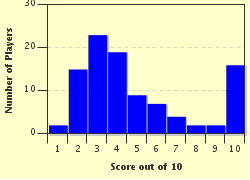Quiz Answer Key and Fun Facts
1. In 1364, the number of dishes that could be served to each level of society (nobles, gentlefolk, commoners etc) was actually laid out in English Law.
How many dishes could be served to a Lord?
2. Which of these now everyday items would you NOT see at an English Lord's banqueting table in the year 1364?
3. When meat is served at a St. George's Day feast (April 23rd) in England, in the fourteenth century, we know that it must be which of these days of the week?
4. If we are served "chibols" at a meal in England, during the fourteenth century, what would we be eating?
5. Which foodstuff could be bought, in 1364 in England, in the various forms "caffetin", "red or white flat", "Cyprus", "pot", "syrup", "water", and "barley", for varying prices?
6. Is it true or false that, at a feast in a noble house in England, in 1364, wine made in England could have been served?
7. During a feast at an English noble household in 1364, one course served may well have included baked fruit such as quince or plums, and dainty morsels of meat from "martinets" - what was a martinet?
8. From his household accounts for the year 1363 - 1364, we know that King Edward III of England bought 170,310 gallons of fine wine! This was ordered, and paid for as 1622 of the units of measurement then in use for wine.
How did King Edward order his wine?
9. During the fourteenth century in England, the various meats that could be served to a noble household at a feast each had their own particular terms to describe their carving and/or serving to the Lord and his family.
Which of these options would be "tranched" at table?
10. At the end of our Feast to celebrate St. George's Day in 1364, we are served with small baked wafers and "hippocras" (also "hypocras").
What is hippocras?
Source: Author
Rowena8482
This quiz was reviewed by FunTrivia editor
WesleyCrusher before going online.
Any errors found in FunTrivia content are routinely corrected through our feedback system.


